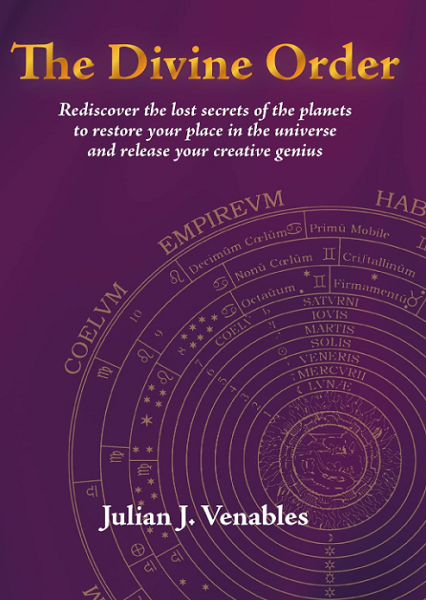
Reaching out for a deeper connection to the inner planets in everyday living, Julian Venables’ latest book The Divine Order is written for the non-specialist. He only includes the celestial ‘wanderers’ as they were once called, that can be seen with the naked eye – Moon to Saturn – to focus on a humanocentric approach. And works through them in an untypical but interesting order. Moon for babyhood, Mercury as the mind develops, Venus at adolescence for romance and relationships, the Sun in the twenties for the phase of ‘I am’. Then onto Mars, Jupiter at the pinnacle of life and Saturn for old age.
Each is listed with associations, colours, parts of the body, appearance, occupations, animals, plants and gemstones to connect to the ancient wisdom that ‘the spiritual can be read through the physical.’
The days of the week – more obvious in French – from Lundi (Moon Monday) through Mardi (Mars Tuesday), Mercredi (Mercury Wednesday), Jeudi (Jupiter Thursday), Vendredi (Venus Friday), Samedi (Saturn Saturday) are also highlighted as a focus for daily meditations and activities on a theme.
Well-laid out with pleasing illustrations and historical references, it will be a valuable self-help book for those wishing to ground their knowledge of the planets and pursue a different route to inner exploration.
Reviews in Amazon:
‘I am really enjoying this book – it is allowing me to connect with the planets and forming a relationship with the energy of the day.’
‘I’ve been trying to get the essence of the planets for some time and this book has helped enormously. It’s a book I will keep referring back to.’

Astrology really relies on the concept of a Great Chain of Being that links all creation. It is world view that is echoed strongly in Shakespeare but to which modern humans are largely deaf
How different is that concept from the Kabbalistic Tree of Life and its sephirot?
Hugh, I think a knowledge of astrology does enrich one’s understanding of much pre-enlightenment art and literature. Lots of Astrology in Chaucer’s Canterbury Tales too.
Also in the writings of herbalist physicians of the 16th/17th centuries, Nicholas Culpepper in his Herbal for instance gives planetary rulership and planets in signs for each plant. The so-called signature of plants – the leaves of lungwort resemble the lung, nettles are ruled by Scorpio because the leaves sting, etc.